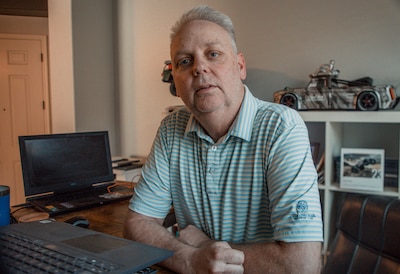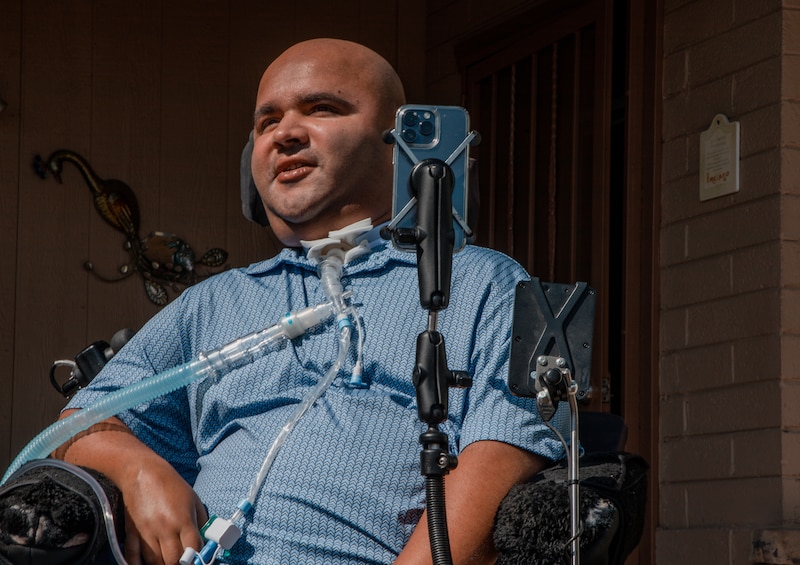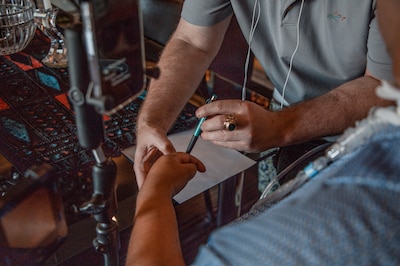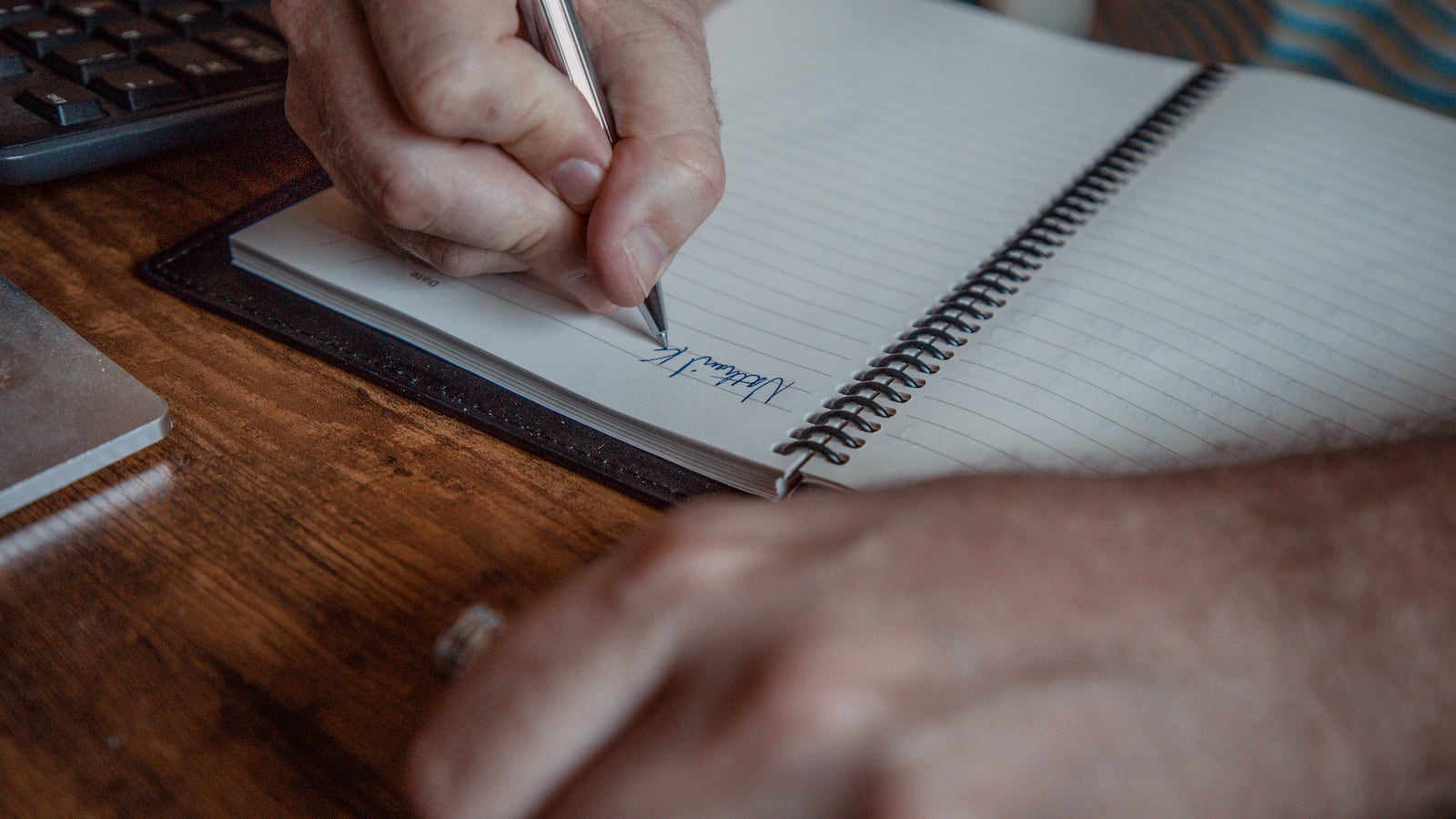This story was published by Votebeat in partnership with the Arizona Center for Investigative Reporting. Votebeat is a nonpartisan news organization covering local election administration and voting access. The Arizona Center for Investigative Reporting is an independent, nonprofit newsroom dedicated to statewide investigative reporting. Sign up for the AZCIR newsletter and Votebeat Arizona newsletter.
Nate Kennedy was in a hurry when he arrived at a Motor Vehicle Division office in 2021 to get his driver’s license. He’d just moved back from out of state and marked the box to register to vote, quickly scribbling his signature on the electronic pad.
He was all set to become one of the thousands of voters not affiliated with a political party who would play a key role in determining the state’s leaders in the next midterm election.
When he submitted his mail ballot in November 2022, however, that messy signature would cost him his vote.
Election officials who compared the signature on his mail ballot envelope to the electronic scribble on file weren’t convinced they came from the same person. So, as the law requires, they rejected his ballot. He didn’t find out until weeks later.
“I was so irritated,” said Kennedy, who lives in Gilbert in Maricopa County. “It made absolutely no sense to me.”
With more people in Arizona and across the country voting by mail, election officials are increasingly relying on the signatures on ballot envelopes to confirm voters’ identities. And in response to unsubstantiated claims of widespread mail voter fraud, some have tightened their signature verification processes.
That’s especially true in Maricopa County, the largest county in Arizona and a focal point of false claims about election fraud. Under a more stringent review process, the number of ballots rejected in the county for questionable signatures tripled, from 586 to 1,798, between the 2020 presidential election and the 2022 midterm. That doesn’t include the ballots rejected because there was no voter signature at all — 1,299 in 2022.
But flaws in the county’s signature verification process may lead to disenfranchisement that disproportionately affects voters who are younger, newly registered or those who do not belong to a political party, Votebeat and the Arizona Center for Investigative Reporting found in a monthslong analysis of the rejected midterm ballots.
In a state where some elections are decided by just a few hundred votes, these rejected ballots — about 3,000 at the state level for mismatched signatures alone in 2022 — could affect the outcome of an election.
Votebeat and AZCIR mailed letters to all 1,798 Maricopa County voters who had their ballots rejected for this reason, analyzed who they are and spoke to more than a dozen of them about their experience.
Newer and younger voters are more likely to have their signature affected, the investigation found, in part because they may only have one signature on file, and that signature is most commonly from their driver’s license record, signed on an electronic pad. Those electronic signatures often don’t capture how a voter really signs their name.
The rejections for mismatched signatures also disproportionately impact voters not affiliated with a political party, in large part because they don’t have the backing of a political party to help contact voters once signature problems are identified.
And the analysis confirms what voter advocates have long said: Older voters and those with disabilities sometimes see their ballots rejected because their signatures have changed over time.
Sandra Lines, a retired forensic document examiner in Paradise Valley who once ran a lab in the Attorney General’s Office, said trying to verify a signature against only a small sample of signatures that were collected for different purposes is “just not a valid thing to do.”
County workers go through hours of training before trying to determine whether someone’s signature is valid. But they aren’t handwriting experts, and the process itself — reviewing millions of signatures in just a few days — doesn’t come close to the type of forensic examination used in other circumstances, such as criminal cases, to validate a signature.
But the checks can have serious consequences: If the voter doesn’t respond to workers questioning their signature in time, their ballot will be rejected.
“It’s an impossible job,” Linton Mohammed, a certified forensic document examiner who testifies in ballot signature court cases, said of the ballot signature verification process. “They may get most of it right, but they are also going to get people being disenfranchised.”
Republican state lawmakers have tried for years to switch to a system in which mail voters are asked to provide an identification number to confirm their identity. A ballot proposition for this plan, pushed by the conservative Arizona Free Enterprise Club, failed narrowly in the 2022 midterm. Greg Blackie, the club’s policy director, said reviewing signatures is a subjective process, and having objective ID requirements is better.
“It would lead to less signatures that are actually good being tossed out and increase the integrity of the process for mail in voting,” Blackie said.
But Alex Gulotta, Arizona state director of All Voting is Local, said it’s best to fix problems with the current system, rather than tossing it all together.
“Signatures are a form of valid identification,” he said. “But we have to collect them in a meaningful and thoughtful way for them to be able to perform that function.”
‘Let down and lied to’: Voters respond to having ballot rejected
The vast majority of Arizonans vote by mail, and, for this election, those ballots are being sent to the 77% of the state’s 4.1 million voters who are on the early voting list.
Those voters must sign their ballot envelope before putting their ballot in the mail or dropping it off at a drop box. Arizona law requires counties to notify voters when they flag an inconsistent or missing signature, and the law gives voters until five days after Election Day to call, text, or visit county offices to fix the problem. This “cure” period, as it is called, coupled with the sheer number of mail ballots cast, is part of what delays the reporting of election results.
Maricopa County’s robust curing process allowed more than 15,000 voters to fix problems with their signatures during the midterm election. But some don’t get the message in time, and there’s concern that there could be more of them this year.
A bipartisan law meant to speed up final results shortened the cure period from five business days to five days total. So voters this year will have until Nov. 10, the Sunday after the election, to respond to inquiries about a missing or mismatched signature.
Many will wait until the last day to vote, which will give them less time to find out about problems with their signature. During the 2022 midterm election, for example, Maricopa County voters dropped off 290,000 mail ballots at the polls on Election Day.
If officials can’t reach someone by phone, they send letters and must rely on the U.S. Postal Service to reach voters. That can take some time, as Votebeat and AZCIR learned by trying to contact the 1,798 voters by mail: Only about half of the letters were delivered within five days.
Gulotta said it often takes several days just for mail to reach voters, and people who use post office boxes may not check them daily. Data from a recent lawsuit, he said, found that some mail delivery in northern Arizona takes up to seven days. “Text, email, and phone are all better means to contact voters,” he said.
Of the 15 voters who responded to our May letter, about half said in a survey that they remember the county notifying them. Two voters said they called the county and tried to fix the issue. One said they had spoken to someone, and believed the problem had been resolved — but then learned from our letter that it hadn’t. Others didn’t know their signatures had been rejected at all.
“Like why did I even vote? Especially when I wrote my signature very neatly, and they reject it.”
— Nicala Schmit, first time voter
“Like why did I even vote?” Nicala Schmit wrote in her reply. “Especially when I wrote my signature very neatly, and they reject it.”
Schmit, now 21, was voting for the first time in 2022. She had her ballot rejected again in 2023 and this year, according to the county’s records.
“Honestly if it were not for you reaching out to me who knows when I would have gotten this issue fixed,” she wrote in an email.
In addition to the survey, a team of reporters reviewed hundreds of other voters’ signatures that were rejected in November 2022. The signatures were often different from what was on file from the MVD or previous elections. That’s not necessarily an indication of fraud, though. Kennedy had voted in the state before, but had only his MVD signature on file because he had just moved back to Arizona. He often signs his name in two different ways, he said, depending on what kind of document he is signing.
“There has to be a better way to do this,” Kennedy said.

It was not possible to find out if or how the county tried to contact the voters who said they didn’t hear from anyone, because the county said it didn’t save this information electronically at the time; it was only noted on the ballot envelope itself. The office has since made this process more trackable by photographing the envelope and adding the image to the voter’s file.
For Litzy Salinas, the experience of having her ballot rejected tainted her first time attempting to vote. “I feel very upset that I’m just finding this out,” she wrote in the survey. “It was my first time exercising my right to vote and I was very proud to do so … I feel let down and lied to.”
In two instances, the person who responded to the letter said the signature on the ballot envelope was, in fact, someone else’s. One who replied on behalf of her mother said her mother was ill at the time and had given her permission to fill out and sign her ballot envelope for her. The other voter said that he asked his mother to sign his ballot envelope because he was out of the country at the time.
Maricopa County Recorder’s Office spokesperson Sierra Ciaramella said the fact that these two ballots were rejected is an “example of our signature verification process working as it should.”
State: Electronic signatures might be ‘blurry’ or ‘messy’
County workers are trained to first look at the broad characteristics of the signature, such as whether it is cursive or print, whether it was written fast or slowly, and the spacing or size. The goal is not to check for an exact match, but to make sure they are “comparable.”
One clear pattern in the review of 2022 signatures, and in a data analysis done separately, were problems with the electronic signatures taken at the Motor Vehicle Division. About 3 out of every 4 people who registered to vote in the state in the last three years did so by signing a pad at the MVD or its satellite offices, according to data from the Secretary of State’s Office.
Mark Songer, a document examiner who trains election workers on signature verification in Colorado, said using a stylus automatically makes a signature different from one done with a pen. Mohammed, the forensic document expert, called electronic signatures “useless.”
The state acknowledges the challenges with electronic signatures. The guide used to train county workers says electronic signatures might be “blurry” or “messy.”
“However, you should not waste time trying to ‘explain away’ the differences that you see,” the guide said. “If you find yourself laboring to do so, you should still flag it for a second check.”
The youngest voters, ages 18 to 24, were most likely to have their ballots rejected, according to Votebeat and AZCIR’s analysis. About 36% of the rejected ballots for mismatched signatures came from that age group, which make up about 9% of the overall voter roll.
Generally, the longer the person had been registered to vote — and the more likely they were to have additional signatures on file — the less likely their ballot was to be rejected. About 34% of these voters had registered to vote either in 2021 or 2022, meaning they would have another signature on file only if they voted in a local election or updated their registration at some point before the midterm.
Reviewing the rejected signatures from older voters, it was obvious to reporters their signatures changed over time and with age. The same is often true for voters with disabilities, said Vicki Cuscino, executive director of the Tucson-based Direct Advocacy and Resource Center.
People who have cognitive disabilities, have trouble with their hands, or who are aging into disability all see their signatures change over time, Cuscino said. She said the signature verification system “reflects institutionalized ableism” by assuming that everyone can sign their name in a small, marked area on the envelope.
Asim Dietrich, a lawyer for Disability Rights Arizona and a voter in Maricopa County, said that his signature was initially flagged as a mismatched signature in a recent election. He experiences paralysis due to muscular dystrophy.
“My signature changed as I got weaker,” he said.

Dietrich said he called the county and verified his signature. Days later, he checked online and there was no record that he did so. Luckily, he had time to call again, and his signature was marked as verified. He said he was concerned not everyone would have the time or resources to call.
Stephen Richer tightens the signature review process
Maricopa County rejected about 0.14% of mail ballots for mismatched signatures in 2022, a low rate compared with some other counties. Cochise and Navajo, for example, rejected 0.67% and 0.61% of mail ballots for mismatched signatures during the midterm election, according to county data.
Cochise County Recorder David Stevens said that rate is fairly consistent for the county, and he doesn’t know why it would be more than other counties. He explained the county has a three-step process for reviewing signatures, with him making the final decision on which are flagged for curing. He described a curing process similar to Maricopa’s.
Maricopa County stands out because its system has been scrutinized, and that scrutiny led Recorder Stephen Richer, a Republican, to tighten the process after he was elected in 2020 — at least partly as a result of criticism from his own party.
He added more steps and training to the process prior to the 2022 election.
The county mostly uses temporary workers for the task, but county employees also pitch in. Anyone who reviews signatures takes an eight-hour forensics class. The temporary workers have an additional two-day training that focuses mainly on signature verification, and county workers take a three- to four-hour class.
The initial reviewer typically has three signatures on file to compare with the voter signature on the envelope, up from one before Richer took office. Of the signatures they approve, 2% are checked again in an audit.
Signatures that are flagged as not comparable go to a manager, who has access to all of the voter’s signatures on file — although for newly registered voters, there would be only one. If the manager rejects it, the county reaches out to the voter for verification.
Even Richer isn’t sold on the process.
“I’d much rather machines do the signature review if possible,” Richer said in an April 2022 tweet. “No bias, no racism, no sleepy, no hungry, no slacking, less cost.” He declined to comment on the investigation’s findings.
Some counties in other states, such as Colorado and California, use computers as the first step in verifying mail voter signatures. Maricopa County used to, but Richer turned it off after some Republicans objected. A GOP-sponsored bill to ban the use of AI in this kind of a process was vetoed by Democratic Gov. Katie Hobbs in 2023.
Political party curing boosted Attorney General Kris Mayes
Despite Richer’s changes, the workers checking early and mailed ballots during the midterm initially flagged roughly the same percentage of mismatched signatures as they did in 2020 — just over 1% each election.
What caused the number of rejected ballots to triple from one election to the next appears to be a more robust curing process. In the 2022 midterm, it appears workers cured a smaller proportion of ballots than in 2020, although exact numbers from 2020 were not available. Of about 18,500 ballots flagged for a mismatched or missing signature in 2022, about 15,500 were cured. In 2020, about 26,000 signatures were flagged, and about 24,000 were cured.
This year, the county hired 14 temporary workers to contact voters who have signature problems, and they started reaching out to voters on Monday, once early ballots started coming in. That’s up from five or six in 2022, but appears to be down from 2020, when at times there were 40 people working on curing.
The office is diligent in its attempts to reach voters, Ciaramella said in an email response to several questions from Votebeat and AZCIR. And depending on demand, she said the office could add up to 40 staff to help with curing.
The county attempts to contact a voter as soon as a manager makes the final call to flag their signature, she said, and tries to reach them three times. The first attempt is a letter, and anyone signed up for the ballot tracking text messages will get an alert. But if the election is less than a week away by the time the signature is flagged, the county calls them instead, if there’s a phone number on file or on their mail ballot envelope. This November, the county is going to text voters directly, too, she said.

Political parties often step in to help counties get signature problems solved before the deadline. A new law this election cycle requires counties to provide political parties a list of voters who need to fix problems with their ballots and update the list daily.
The curing effort by parties was especially notable in 2022, when candidates for attorney general were in a tight race.
The group organizing the Democratic effort for Kris Mayes told the Arizona Republic they believe their efforts — going door to door, calling and texting voters — spurred 3,400 people to cure their ballots by the deadline. Mayes ended up winning the attorney general’s race by 280 votes.
People who were not registered with a party represent just 31% of registered voters in Arizona, but they accounted for about 40% of those whose ballots were rejected for mismatched signatures in 2022, the Votebeat/AZCIR analysis shows.
That pattern could also be explained by the fact that newly registered voters are less likely than more established voters to be registered with a party.
Progressive lobbyist Marilyn Rodriguez said disparities highlight the need for counties to devote more resources and have more time for curing. If not, it’s an uneven playing field, she said, based on “who has the time, capacity, people power, and contact information to go and chase the people down.”
Conservatives and voting rights groups disagree on solutions
While 31 states use signature verification to verify the identity of mail voters, several states including Georgia and Texas require an identification number. A few states require a witness, and 10 states verify that a signature is present but don’t examine it.
Blackie and the Free Enterprise Club believe eligibility should be determined in the same way for every voter. The proposal on the ballot in 2022 would have made free state voter ID cards available, Blackie said, to get around the concern that some voters might not have another type of ID.
But Gulotta and others believe that requiring ID numbers would lead to more rejected ballots. A 2021 analysis by the MIT Election Data and Science Lab found that states that require both signatures and ID generally reject more ballots, but little research has been done directly comparing the two methods.
Gulotta said that instead of changing the system entirely, one relatively easy fix would help: The Motor Vehicle Division could use better technology to collect more accurate driver’s license signatures, or even collect a pen-and-ink signature instead. And it could help educate voters that it will be used to verify their identity when they vote by mail.
Barbara Smith Warner of the National Vote at Home Institute, which promotes mail voting, said Arizona counties could take a look at the design of their ballot envelope to make sure it’s educating voters on how the signature will be used.
Maricopa County’s ballot envelope warns voters that the ballot will not be counted without their signature, but the warnings are small.
In Pima County, Recorder Gabriella Cázares-Kelly recently changed the envelope design, adding multiple warnings in red, with a large, bold “Wait!” to emphasize the importance of the signature.
As of this year, all Arizona counties also offer ballot tracking services. These services allow voters to send a text to initiate the process of fixing the problem with their signature.
Only 257,000 Maricopa County voters are signed up for ballot tracking via email or text message, while nearly 2 million voters are on the county’s active early voting list.
Kennedy is now one of them. He supports using voter ID instead of signatures to verify mail voter identity, but overall says he wants to see that “everyone who wants to vote will have their votes counted.”
“These elections are so close,” he said. “Simple mistakes can choose the course of leadership for years. So I would like to avoid them, if possible.”
Brandon Quester, Maria Polletta and Natasha Yee from the Arizona Center for Investigative Reporting contributed.
Jen Fifield is a reporter for Votebeat based in Arizona. Contact Jen at jfifield@votebeat.org. Hannah Bassett is a reporter for the Arizona Center for Investigative Reporting. Contact Hannah at hannah.bassett@azcir.org.

